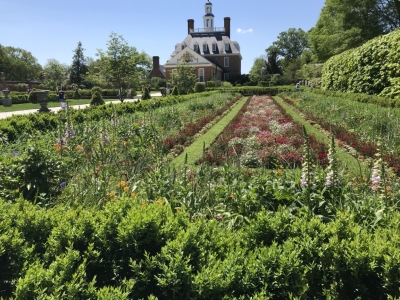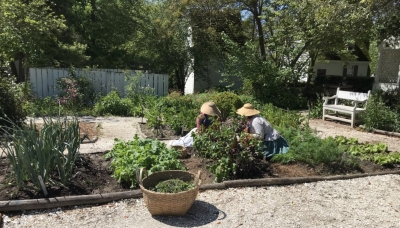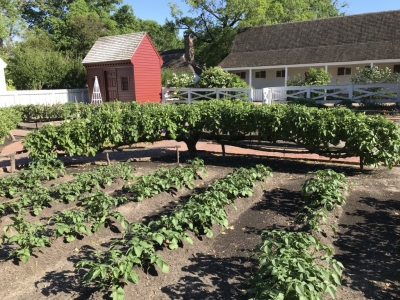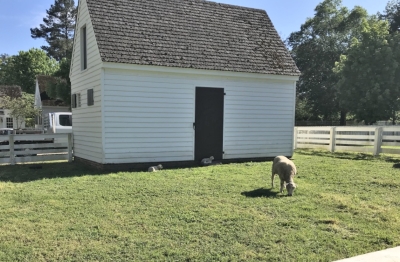TIME TRAVEL
18th Century, Here I Come!

Is that me playing the fife? No.
I just returned from time travel one month forward and a couple hundred years backward. Both at the same time! I did this with a trip to Colonial Williamsburg, Virginia, where black locust trees were in full bloom, which is about a month ahead of when they will be blooming up here in New York’s Hudson Valley.
The impetus for this time travel was Colonial Williamsburg’s Annual Garden Symposium, at which I was one of the presenters. (I did presentations on espalier fruit plants and on growing fruits in small gardens.)
Williamsburg is a magical place anytime of year, and especially so, for me, in spring. (I first fell in love with the place on a family trip when I was 7 years old; on subsequent visits, I’ve forgone the three-cornered hat I wore on that first trip.)

The governor’s garden
The Symposium included tours through many of the colonial gardens, where we could see, in action, “colonial” gardeners caring for their plants — in many cases using some of the same techniques we use today. Glass cloches, for instance, covered portions of some gardens to hasten warming of the soil for earlier sprouting of seeds.  Flowering meads of herbs, flowers, and grasses blanketed the ground beneath most of the orchards, providing — probably unknown back in colonial days — forage for beneficial insects to help protect crop plants.
Flowering meads of herbs, flowers, and grasses blanketed the ground beneath most of the orchards, providing — probably unknown back in colonial days — forage for beneficial insects to help protect crop plants.
The flowers and vegetables — and fruits in the orchards — are the kinds and varieties grown in colonial times: cardoon, cornflower, chives, cockscomb, pot marigold, nasturtium, hollyhock, Johnny-jump-up, Tennis Ball lettuce, Yellow Crookneck squash, chard, and, of course, corn. Field corn, probably, but also, possibly, sweet corn, which was first given by the Iroquois to settlers in the late 18th century.

Espalier apple trees border vegetable plots
The gardens in Williamsburg provided and provide more than just sustenance. As in the orchards, flowers mingle with crop plants, in this case, vegetables. Most yards in the reconstructed town are one-half acre, with the land separated into sections with white wood fencing. The whole effect is très charmante. Couple that look with the lack of automobiles within the reconstructed town, and the quiet nights illuminated by the soft glow of fire and candle light (supplemented by electric lights with a candle-like glow), and I think I may want to move back into the 18th century.
Wall Envy
One problem I had with Colonial Williamsburg was wall envy. The church on Duke of Gloucester street, the governor’s mansion, and some other public spaces were enclosed by beautiful brick walls capped with functional and decorative rounded brick.
Most of the homes were covered with white-painted, wooden clapboards. The church and the governor’s mansion were made of brick, which, obviously, harmonized well with their brick walls.  My own home is brick; even a few four-foot-high walls around my vegetable garden and in other areas would improve the general appearance — and provide, warmer microclimates for cold-tender plants or early harvests. Not that the rustic locust fencing and arbors enclosing my vegetable garden look unsightly . . . but I’d like some brick walls.
My own home is brick; even a few four-foot-high walls around my vegetable garden and in other areas would improve the general appearance — and provide, warmer microclimates for cold-tender plants or early harvests. Not that the rustic locust fencing and arbors enclosing my vegetable garden look unsightly . . . but I’d like some brick walls.
Incidentally, bricks are made on site at one of the many trades demonstrated within the reconstructed town. I stopped in at the gun shop and stayed soaking up history I never learned in school — how most colonists owned relatively inaccurate muskets which were good enough for hunting and keeping varmints out of gardens, and the real sharpshooters were those with “long rifles,” that is, firearms with rifled barrels that spun their lead shot. But winning a battle wasn’t all about sharpshooters. Long rifles took much longer to reload than muskets, and which side threw the most lead in the air often was what decided who won.
(As part of my immersing myself in 18th century life, I signed up to go to a shooting range to actually fire a flintlock musket. This event, as recorded with 21st century technology, a phone, is documented Musket shooting1, Williamsburg, Musket shooting2, Williamsburg.)
Bricks, rifles, furniture: all these trades are practiced as they would have been in the 18th century. The rifle maker begins his work with nothing more than a block of wood and a block of iron. Four-hundred hours later, he has in hand a finished rifle. Fabric artisans begin with a sheep or flax seeds and some natural dyes. Cabinetmakers begin with trees or rough cut wood. Their tools are the same as those that to which their 18th century forebears had access.
Plant Envy
In addition to my wall envy, I also experienced the usual plant envy that afflicts me when I go south. Southern magnolia tree reach majestic proportions in Williamsburg; I would like to, but cannot, grow them in this cold climate. Crape myrtle is another, for its flowers and its bark mottled in pastel shades; too cold here for this one also.
I did come upon a number of specimens of fringe tree (Chionanthus spp.), with which I’m only vaguely familiar. The fringes of white blossoms dangling in profusion from the branches made me want to become more familiar, i.e. to plant, this shrubby tree. It turns out that I could — and will — grow fringe tree.

